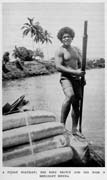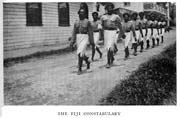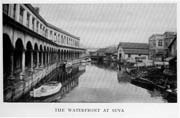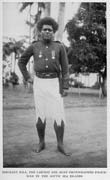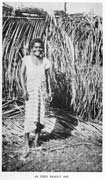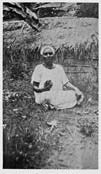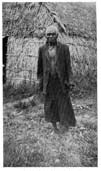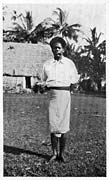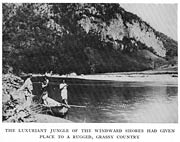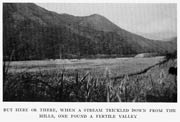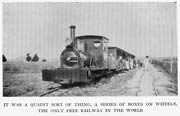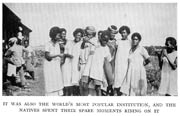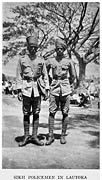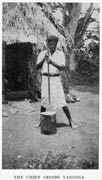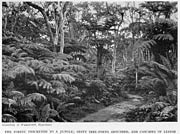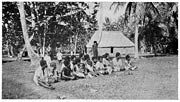|
"A Fijian Boatman" p.138 Foster spoke in very positive terms about the Fijian boatmen he first encountered enroute from Tonga to Fiji, from their "superior physique" to the fact that they "were ever ready at the slightest excuse, or no excuse at all, to burst into roars of deep-throated laughter that broke like the explosion of a dynamite bomb." He quoted an Australian seaman on the boat saying "they're the best workers in the islands — if they feel like it. One of those jokers can shoulder a bag of sugar that would take four white men to lift. I saw one of them come down to the dock a few weeks ago with a two hundred pound stoker on his back. Just out of sheer kindness, mind you, for the Aussie was drunk…" (pp.135-7). |
|
|
"The Fiji Constabulary" p. 152 |
|
|
Nabukalou Creek p. 152 Captioned "The Waterfront of Suva", actually this is a photograph of Nabukalou Creek, taken from the bridge in Renwick Road, with the Morris Hedstrom colonnade on the left and the backs of the shops in Cumming Street (at that stage still called "All Nations Street") on the right. |
|
|
"Sergeant Sola" p. 164 As the caption describes, this policeman was much-photographed, and appeared on many postcards of the time. |
|
|
Teenage girl p. 172 |
|
|
Solomon Islands woman p. 194 Foster went to Vatuwaqa, not too far from Suva, with the express purpose of "looking at" Solomon Islanders whom he had heard lived there. These were native-born Solomons people who had been indentured-cum-slave labour brought to Fiji during the blackbirding days, and who for a variety of reasons had stayed on (this subject is explored at a simple level in the book "Living on the Fringe" which I have reviewed on this website. This old woman, whose English name was Lizzie, had been in domestic service to European families for many years and therefore spoke broken English. |
|
|
Solomon Islands man p. 194 The voyeurism of Foster's expedition to Vatuwaqa, in the company of a young Australian woman, was obnoxious and made worse by the fact that they intruded (literally and physically) into a funeral being conducted for an old woman of the settlement. The old man in this photograph was the husband of the deceased, and was understandably disgusted by their presence and reluctant to be photographed. He succumbed to bribery in the form of cigarettes and some money. Given the circumstances under which they were taken, I thought hard about including these, but did so only because there are so few pictures of the indenturees who played such an important role in early colonial Fiji, and my purpose is to honour them, not gawk at them. |
|
|
Man in Church attire p. 206 It would not be unusual to see a man dressed similarly to this for Church today, though the use of a cummerbund (reminiscent of the former i-oro of masi or magimagi) would be unusual today. Also, he would be unlikely to have a pipe between his teeth as this man did — almost certainly affected for the photograph and not an accompaniment into church. |
|
|
Two women in Church attire p. 206 It would also not cause any surprise to see women like these two, on their way to church today. The one on the right carries her Bible or hymnal in her hand. |
|
|
NW Vitilevu coastline p. 222 Foster travelled by boat anti-clockwise around Vitilevu, and this photo reflects his observation of the change that occurs on the "dry side" first met in northwestern Vitilevu. |
|
|
River delta and canefields p. 222 Foster commented on the canefields growing righ near the river-mouths in the northwest. He did not identify which ones they were. |
|
|
The Lautoka-Ba free passenger train p.232 |
|
|
Train passengers p. 232 The youth capering in front of the camera to show off to the girls is still something one will often encounter — and not just in Fiji either! |
|
|
"Sikh policemen in Lautoka" p.244 is was the uniform of these policemen right through the 1940s. From memory, the slacks worn today in place of the jodhpurs and puggarees were adopted in the 1950s. |
|
|
"The chief grinds yangona [yaqona]" p.244 The man is pounding yaqona [kava] root using an iron bar in a wooden tabili.Today the latter have been replaced universally by all-steel models. |
|
|
Young man wearing his isuluvakatoga p.262 This young man was actually a prisoner (as was usually the case, for non-payment of taxes) and was assigned to Foster by the DC at Nadarivatu to act as his porter and guide him to Vunidawa across the mountains, whence he could catch a government launch to Suva. His garment of choice for the trip was the wrap-around length of cloth or isuluvakatoga. A good deal of the description of him in the book is of his prodigious appetite. |
|
|
The bush track p.274 This was the uniform of these policemen right through the 1940s. |
|
|
Young learners p.288 The youngsters are practising their skills at the meke or seated dance, and serving yaqona. |
|
|
Women seated in preparation for meke practice p.298 |
|
|
Group of men seated in front of chief's house The chief sitting on the ramp into the house is wearing his red-brown-dyed i-sala headscarf. The man on the far right has lime in his hair. |
